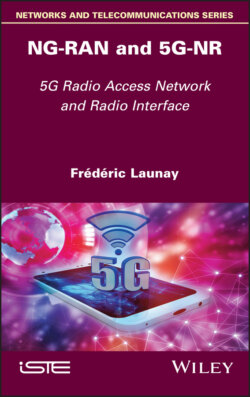Читать книгу NG-RAN and 5G-NR - Frédéric Launay - Страница 11
1
NG-RAN Network – Functional Architecture 1.1. Functional architecture NSA/SA
ОглавлениеUnlike previous generations of mobile networks, the deployment of 5G does not require the simultaneous implementation of the 5G core network (5GC) and the NG-RAN (Next-Generation Radio Access Network).
NSA (Non-Standalone Access) and SA (Standalone Access) are two 5G network models:
1 – SA is a completely new core service-based architecture: each radio node is autonomously controlled by the 5G core network. A service-based architecture delivers services as a set of NFs (Network Functions). NFs in the 5G core network are cloud native;
2 – NSA relies either on the 4G core network or on the 5G core network. NSA anchors the control signaling to the core network through a radio MN (Master Node). The MN is either a 4G radio node or a 5G radio node. The MN controls an SN (Secondary Node) (4G radio node or 5G radio node) according to the DC (Dual Connectivity) mechanism.
The 5G-SA architecture requires the deployment of a 5G core network connected to the NG-RAN.
The 5G-NSA architecture and the 5G-SA architecture were introduced in Release 15 of the 3GPP standard.
The 5G-NSA configuration implements the MR-DC (Multi Radio Dual Connectivity) architecture.
Figure 1.1. Deployment in the SA mode
Dual connectivity involves two RAN nodes, i.e. master node (MN) and secondary nodes (SN) which has the following features:
1 – the MN is connected to the core network for the control plan (signaling) and for the user plane;
2 – the SN is controlled by the MN. It is connected to the MN for the control plane (C-plane). The user plane (U-plane) is either connected to the MN or connected to the core network;
3 – the master radio access node controls the secondary radio access node and establishes a bearer, if necessary, for the exchange of data between the two radio nodes.
Dual connectivity defines the “Master Cell Group (MCG) bearer” and the “Secondary Cell Group (SCG) bearer”.
The MCG carries data that will be transmitted on the radio resources allocated by the MN. In the case of carrier aggregation, the MN supports data on the PCell (Primary Cell) and SCells (Secondary Cells).
The SCG carries data that will be transmitted on the radio resources allocated by the SN. In the case of carrier aggregation, the SN supports data on the PCell and SCell.
The split bearer consists of routing the traffic between the MN and the SN. According to the U-plane termination, the split bearer consists of splitting either the MCG bearer or the SCG bearer.
For E-RABs configured as “MCG bearers”, the U-plane termination point is located at the MN.
For E-RABs configured as “SCG bearers”, the U-plane termination point is located at the SN.
For the core network configuration, each support (MCG, SCG, split bearer) can end on the MN and/or on the SN. The split bearer is transparent for the core network entities.
Several deployment scenarios (Figure 1.2) have been defined for the 5G-NSA:
1 – option 3: the E-UTRAN access network is connected to the 4G core network. The master node is the 4G radio node (eNB – evolved Node B). The secondary node is the 5G radio node (en-gNB). The MR-DC architecture is called EN-DC (E-UTRAN NR Dual Connectivity);
2 – option 4: the NG-RAN access network is connected to the 5G core network. The master node is a 5G radio node (gNB – next generation Node Base Station). The secondary node is a 4G radio node (ng-eNB). The MR-DC architecture is called NE-DC (NR – E-UTRAN Dual Connectivity);
3 – option 7: the NG-RAN access network is connected to the 5G core network. The master node is a 4G radio node (ng-eNB – next generation eNB). The secondary node is a 5G radio node. The MR-DC architecture is called NGEN-DC (NG-RAN E-UTRAN NR Dual Connectivity).
Figure 1.2. NSA configuration options
